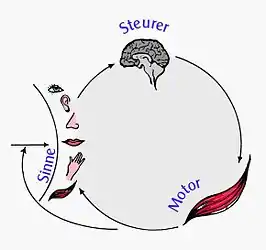Verhaltenskybernetik
Verhaltenskybernetik bezeichnet ein Spezialgebiet der experimentellen Psychologie, das zu Beginn der 1960er Jahre an der psychologischen Fakultät der Universität von Madison/Wisconsin erstmals etabliert wurde. Maßgeblicher Initiator, langjähriger Lehrstuhlinhaber und Vorstand des Behavioral Cybernetics Laboratory war Karl Ulrich Smith.[1] Smith war u. a. Gründungsmitglied der International Ergonomic Society.

Das Forschungszentrum in Madison war – als eine der ersten nichtmilitärischen Einrichtungen in den USA – mit den modernsten technischen Hilfsmitteln der damaligen Zeit ausgestattet (Großrechner etc.).[1] Fernseh- und Computergestützte Echtzeit-Bewegungsanalyse wurden genutzt, um folgende Bereiche zu untersuchen:
- die operationale Autonomie lebender Systeme
- die Bedeutung der eigenen Bewegung für Lernprozesse
- die Auswirkung von Störungen auf Lernprozesse
- Interaktion lebender Systeme
- Mensch-Maschine Interaktion
- Mensch-Computer Interaktion
Erkenntnisse dieser Forschungstätigkeit fanden auch unter dem Begriff Human Factoring Verbreitung. Entwicklungen im Bereich der Verkehrssicherheit und im rehabilitativen Bereich sind ebenfalls auf die Forschungstätigkeit am Behavioral Cybernetics Laboratory zurückzuführen.
Im deutschsprachigen Raum gehört Bernhard Hassenstein zu den Begründern der Verhaltenskybernetik.
Literatur
- Bernhard Hassenstein: Kybernetik und biologische Forschung. Akademische Verlagsgesellschaft Athenaion, Frankfurt am Main 1966.
- Bernhard Hassenstein: Biologische Kybernetik. Eine elementare Einführung. Quelle und Meyer, Heidelberg 1967.
- K. U. Smith: Social tracking in the development of educational skills. In: American Journal of Optometry and Physiological Optics. Band 49, 1972, S. 50–60.
- T. J. Smith, R. A. Henning, K. U. Smith: Sources of performance variability. In: G. Salvendy, W. Karwowski: Design of work and development of personnel in advanced manufacturing. Wiley, New York 1994, S. 273–354.
- T. J. Smith, R. A. Henning, K. U. Smith: Performance of hybrid automated systems - a social cybernetic analysis. In: International Journal of Human Factors in Manufacturing. Band 5, Nr. 1, Wiley, New York 1995, S. 29–51.
- K. U. Smith: Physiological and Sensory Feedback of the Motor System: Neural-Metabolic Integration for Energy Regulation in Behavior. In: J. D. Maser: Efferent organization and the integration of behavior. Academic Press, New York 1973, S. 20–66.
- K. U. Smith, V. Putz: Feedback factors in steering and tracking behavior. In: Journal of Applied Psychology. Band 54, Nr. 2, 1970, S. 176–183.
- K. U. Smith, V. Putz: Feedback analysis of learning and performance in steering and tracking behavior. In: Journal of Applied Psychology. Band 54, Nr. 3, 1970, S. 239–247.
- J. P. Henry, R. Junas, K. U. Smith: Experimental cybernetic analysis of delayed feedback of breath-pressure control. In: American Journal of Physical Medicine. Band 46, Nr. 4, 1967, S. 1317–1331.
- K. U. Smith: Cybernetic Psychology. In: R. N. Singer (Hrsg.): The Psychomotor Domain: Movement Behavior. Lea & Febiger, Philadelphia 1972, S. 285–348.
- T. J. Smith, K. U. Smith: Cybernetic factors in motor performance and development. In: D. Goodman, R. B. Wilberg, I. M. Franks (Hrsg.): Differing Perspectives in Motor Learning. (= Advances in Psychology, Memory, and Control. Band 27). Elsevier, Amsterdam 1985, ISBN 0-444-87761-4, S. 239–283.
- K. U. Smith, J. Henry: Cybernetic foundations of rehabilitative science. In: American Journal of Physical Medicine. Band 46, Nr. 1, 1967, S. 379–467.
- K. U. Smith, T. J. Smith: Feedback mechanisms of athletic skill and learning. In: L. Smith (Hrsg.): Motor skill and learning. Athletic Institute, Chicago 1970, S. 83–195.
- K. U. Smith: Physiological and Sensory Feedback of the Motor System: Neural-Metabolic Integration for Energy Regulation in Behavior. In: J. D. Maser: Efferent organization and the integration of behavior. Academic Press, New York 1973, S. 20–66.
- S. L. Sauter: A Cybernetic analysis of the behavioral-respiratory modulation of heart rate and heart-rate variability. PhD. Dissertation. University of Wisconsin-Madison, Wisconsin 1975.
- T. J. Smith, K. U. Smith: Feedback-control mechanisms of human behavior. In: G. Salvendy (Hrsg.): Handbook of Human Factors. Wiley, New York 1987, S. 251–293.
- T. J. Smith, K. U. Smith: Behavioral cybernetic basis of cognitive performance. Experimental and theoretical analysis. In: Ergonomics. (Special Issue on Methodological Issues in Cognitive Ergonomics) 1988.
- J. Gould, K. U. Smith: Angular displacement of visual feedback in motion and learning. In: Perceptual and Motor Skills. 17, 1963, S. 699–710.
Weblinks
- T. J. Smith, K. U. Smith: Thy Cybernetic Basis of Human Behavior and Performance. In: G. Williams: Continuing the Conversation. A Newsletter of Ideas in Cybernetics. Band 3, Nr. 15, 1988. (behavioral.cybernetics.cc)